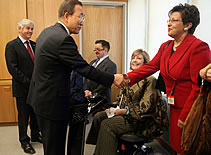Act Now

Empower U: Learn to Access Your Disability Rights Training on Canadian Human Rights, the Convention on the Rights of Persons with Disabilities (CRPD) and its Optional Protocol (OP) training aims to increase awareness of how to address discrimination using more familiar Canadian human rights laws such as Human Rights Codes and the newer international Convention on the Rights of Persons with Disabilities (CRPD). This is training for persons with disabilities by persons with disabilities. The training is part of a project funded by Employment and Social Development Canada and implemented by the Council of Canadians with Disabilities (CCD) in collaboration with Canadian Multicultural Disability Centre Inc. (CMDCI), Citizens With Disabilities – Ontario (CWDO), Manitoba League of Persons with Disabilities (MLPD) and National Educational Association of Disabled Students (NEADS). Read more.
Sign Up for our monthly digest
A monthly newsletter from CCD about what is happening in the community
CRPD - 10 Facts Canadians Should Know
Related Documents
December 3, 2023
Opinion: It's time we made room for people with disabilities
December 3, 2023
International Day of Persons with Disabilities 2023
June 6, 2023
UN Conference of State Parties: Connecting Disability Organizations
-
In 2010, Canada renewed its commitment to people with disabilities, about 14.3% of the Canadian population, by ratifying the UN Convention on the Rights of Persons with Disabilities (CRPD), a human rights treaty, ratified by 126 countries. -
CRPD, which includes civil, cultural, economic, political and social rights, explains human rights in the context of disability, clarifying how to protect and promote the human rights of persons with disabilities. Example: If people with disabilities are to enjoy fully the right to work, there need to be laws prohibiting discrimination in the workplace and requiring employers to provide barrier free workplaces (i.e. worksites that follow the principles of universal design and use accessible information and communication technology). -
From 2002 to 2006 Canadians with disabilities and their organizations participated in the CRPD’s development. -
The CRPD enshrines the human rights and social models of disability, displacing the medical and charity approaches. The CRPD focuses on removing barriers that prevent participation by people with disabilities. -
The CRPD has 8 guiding principles: Respect for dignity and individual autonomy; Non-discrimination; Full and effective participation and inclusion; Respect for difference and acceptance of persons with disabilities as part of human diversity; Equality of opportunity; Accessibility; Gender equality; Respect for the evolving capacities of children with disabilities. -
The CRPD promotes a twin-track approach to disability issues, combining mainstreaming disability in all society’s initiatives with disability-specific measures to ensure equality for persons with disabilities. -
When it ratified the CRPD, Canada made a commitment to the progressive realization of economic, social and cultural rights. -
The CRPD includes national and international monitoring mechanisms. As the CRPD acknowledges the role of civil society in monitoring, all Canadians can be important partners in Canadian monitoring. -
Two years after ratification, states must report to the UN Committee on the Rights of Persons with Disabilities, an independent expert panel, which monitors CRPD implementation. Canada is due to submit its first report, which will provide an important baseline against which to measure future progress on disability issues. -
Disability organizations are monitoring how Canada is meeting CRPD’s standards. Canadians can contribute to building an inclusive and accessible Canada by demanding a robust CRPD implementation plan by all Canadian jurisdictions.

Canadian Foreign Minister Lawrence Cannon, far left, observes as U.N. Secretary-General Ban Ki-moon, second from left, meets members of the Canadian delegation including Steven Estey, center, with the Council of Canadians with Disabilities; Traci Walters, second from right, with Independent Living Canada; and the Canadian Association for Community Living President Bendina Miller, far right, at the United Nations in New York, Thursday March 11, 2010. Canada ratified the U.N. Convention on the Rights of Persons with Disabilities, a historic first international treaty that comprehensively recognizes the rights of persons with disabilities. (AP Photo/Bebeto Matthews)
